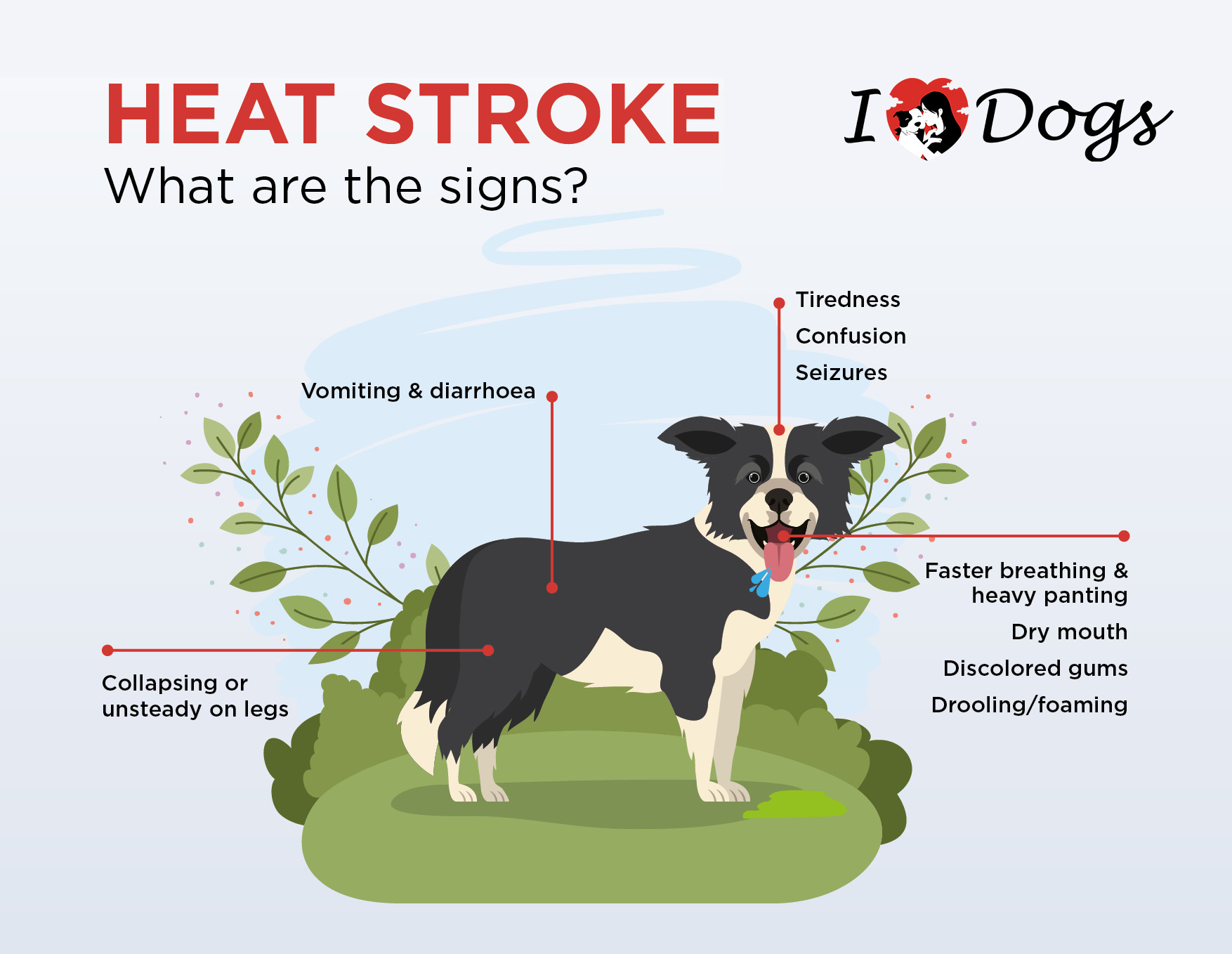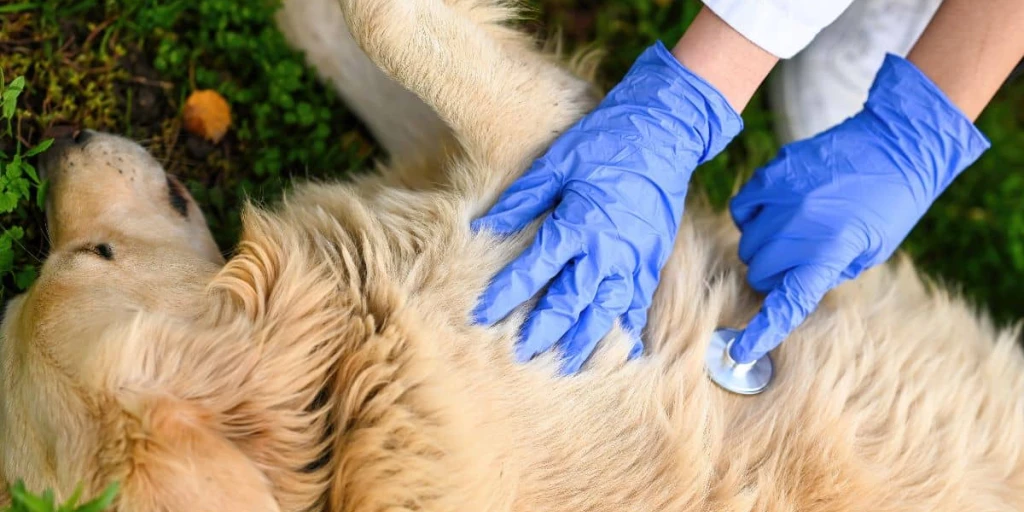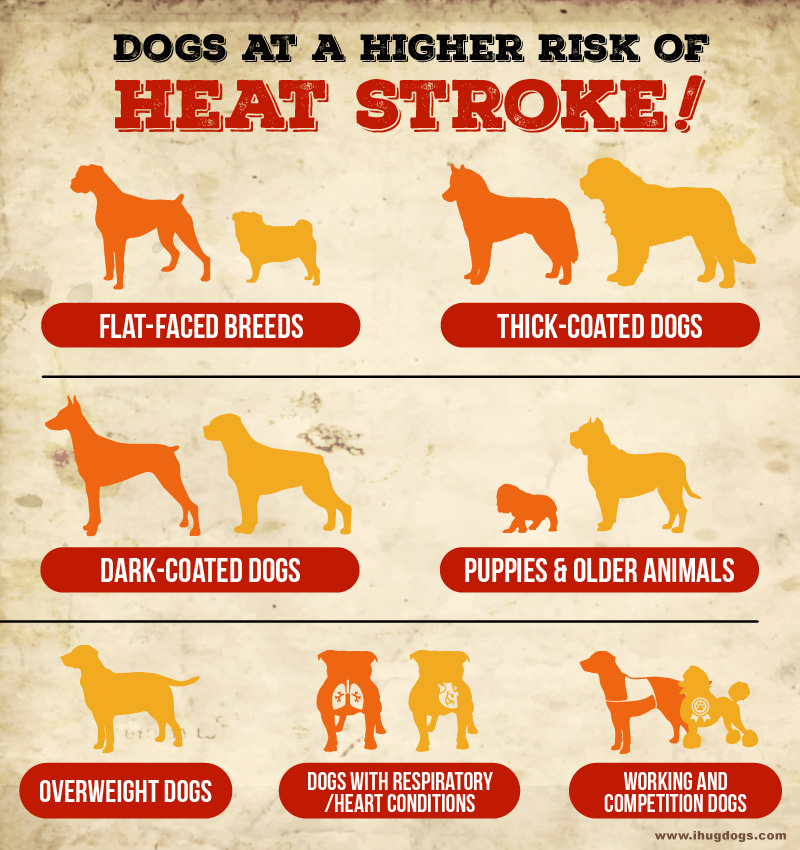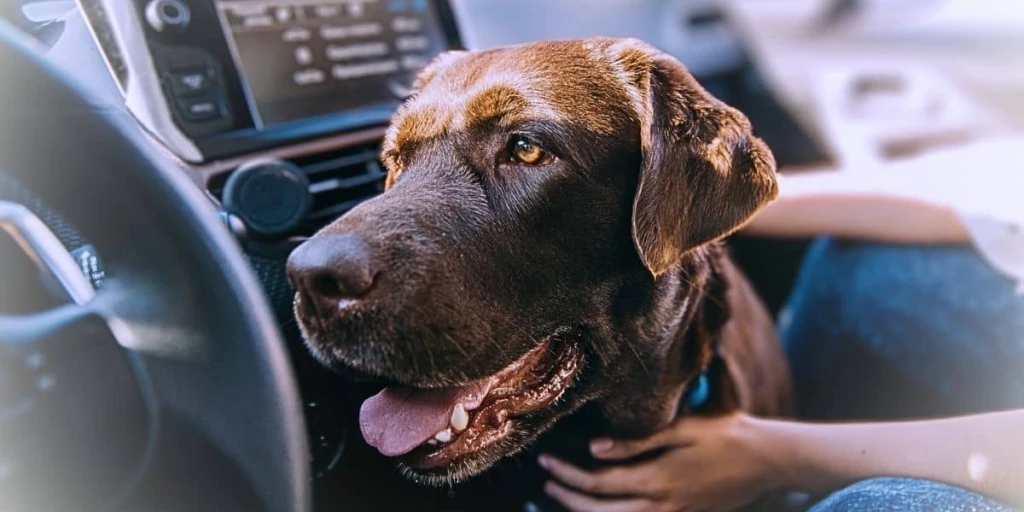There is hardly anything better than spending a warm summer day outdoors with our beloved four-legged companions. However, heat exhaustion and heatstroke are often underestimated in these situations.
In this post, our veterinarian Sarah explains:
- How to protect your dog from heat exhaustion and heatstroke
- What first aid measures are available
- Which symptoms to watch for to ensure your dog’s health and safety.
- Why Dogs Pant in Warm Weather
- What Is Heat Exhaustion, and When Does It Lead to Heatstroke?
- Symptoms of Heat Exhaustion: What Happens to Your Dog
- First Aid Measures for Heatstroke and Heat Exhaustion in Dogs
- Which Dogs Are Particularly Vulnerable?
- Checklist: Determine Your Dog’s Individual Risk of Heat Exhaustion and Heatstroke
- Tips on How to Protect Your Dog in Summer
- Can I Leave My Dog in the Car During Summer?
- Can my dog get sunburn?
- Summary: Our 8 Tips Against Heat Strokes
- Frequently Asked Questions
Why Dogs Pant in Warm Weather
You’re familiar with it: it’s summer, or you’re on vacation with your dog, and he starts panting in warm weather.
Did you know that dogs begin to reduce their activity and seek cooler places at an outside temperature of about 68°F? This is because they cannot regulate their body temperature like us through simple sweating. Although dogs have sweat glands on their paws and nose, these are not sufficient to quickly release excess heat. This is where panting comes into play.
Panting allows the evaporation of saliva and upper respiratory secretions, facilitating the release of accumulated heat. However, this mechanism works only up to an outside temperature of about 86°F. Beyond that, your dog may experience heat exhaustion.
What Is Heat Exhaustion, and When Does It Lead to Heatstroke?
When we talk about heatstroke in dogs, it means the dog is overheated and cannot release excess heat quickly enough.
Heat exhaustion occurs when your dog’s body temperature exceeds 103,1°F (39.5 °C). At this point, the body’s cooling mechanism is no longer sufficient, and your dog begins to show initial signs of reduced bodily functions.
If the body temperature reaches 105,8°F (41 °C) and continues to rise, the risk of heatstroke arises. At 109,4°F (43 °C), the body is in acute danger.
Experiencing a heatstroke does not mean your dog will die. Dogs can recover from a heatstroke if prompt and proper action is taken. Following a heatstroke, your dog may become dehydrated and, in severe cases, develop cerebral edema.
Early signs of a heatstroke include:
- Heavy panting
- Rapid, shallow breathing
- Restlessness
There are two types of heatstrokes:
1. Heatstroke due to a hot environment with high humidity: Warm temperatures raise the body temperature, but high humidity complicates heat dissipation, leading to a heatstroke.
2. Heatstroke due to excessive physical activity: Physical activity (running, playing, etc.) increases the dog’s body temperature. If the exercise is too strenuous or lasts too long, the dog cannot rest and dissipate the accumulated heat, resulting in a heatstroke.

Symptoms of Heat Exhaustion: What Happens to Your Dog
With heat exhaustion, you usually notice heavy panting as the first sign. Additionally, restlessness, an extended neck with a protruding tongue, increased drinking, seeking cold resting places, and a highly reddened and warmer inner ear may be observed. Your dog becomes increasingly apathetic.
If these intrinsic measures are insufficient for cooling, a heatstroke may follow.
Your dog’s pulse quickens, the tongue and mucous membranes become highly reddened, balance disturbances occur, and vomiting or diarrhea may ensue.
In the worst-case scenario, a life-threatening circulatory collapse follows. Your dog’s mucous membranes turn blue, he begins to tremble, convulse, and then falls into a coma, leading to organ failure and death if left untreated.
First Aid Measures for Heatstroke and Heat Exhaustion in Dogs
At the first signs of heat exhaustion, you should find a cool place and, if possible, measure your dog’s body temperature. Afterward, you can begin cooling your dog.
Caution: Rapid cooling can also be dangerous!
- Start by wrapping paws and limbs with damp towels or compresses. Proceed from the belly and hips forward to the neck.
- Then, work your way from the belly and hips forward to the neck.
- It is crucial to offer your dog as much water as needed.
- However, make sure that the water is lukewarm.
- Ice-cold water can further strain the circulation.
Once you have successfully restored your dog to a normal body temperature, you can remove the damp towels. Nevertheless, you should continue to observe him for a while and, if necessary, consult your veterinarian.
If your dog has suffered a heatstroke and the temperature is above 105,8°F (41 °C), you should check if he is still conscious.
If yes, stabilize him as you would in the case of heat exhaustion and contact your veterinarian or the emergency veterinary service in your city.
If your dog is unconscious after heatstroke, place him in a stable lateral position, gently stretch the head and neck, and pull the tongue slightly to keep the airways open. Subsequently, seek immediate veterinary attention.

Which Dogs Are Particularly Vulnerable?
While there are dog breeds accustomed to high temperatures, others suffer greatly due to extreme heat.
A study from the UK, published in 2017, revealed that brachycephalic (short-nosed) breeds are particularly susceptible to heatstroke.
In general, dogs with weakened immune systems, those overweight, or in very young or old age are more affected.
Breeds with long, dense fur and a thick undercoat, such as Huskies, Golden Retrievers, Bernese Mountain Dogs, and German Shepherds, are at a higher risk. Also, breeds with short muzzles and flat faces (brachycephalic breeds) like Boxers, French Bulldogs, and Pugs are vulnerable. Their shortened noses result in reduced oxygen circulation, making them more prone to exhaustion and respiratory distress.

Checklist: Determine Your Dog’s Individual Risk of Heat Exhaustion and Heatstroke
The more “yes” answers you have to these questions, the higher the risk of your dog experiencing heatstroke:
- Does your dog belong to one of the vulnerable breeds?
- Is your dog overweight or underweight?
- Does your dog weigh more than 110,231 lbs (50 kg)?
- Does your dog have long fur?
- Does your dog have a short snout/flat face?
- Does your dog lack access to water?
- Does your dog get physically exhausted quickly?
- Is your dog male?
- Does your dog have heart problems?
If you answered “yes” to several of these questions, you should be particularly vigilant in protecting your dog from heatstroke.
Tips on How to Protect Your Dog in Summer
Since your dog needs daily exercise even in summer, adjust your walking routine. Early mornings or late evenings are best.
If you’re out during midday or afternoon heat, try to avoid asphalted paths and sidewalk tiles. The stored heat can cause mild burns on your dog’s sensitive paws.
- Ensure you always have sufficient water and carry a collapsible bowl or a water bottle for dogs.
- If you’re staying outdoors with your dog for an extended period, provide a shaded area.
If your dog enjoys water, lakes and rivers can offer both exercise and cooling.
At home, you can also treat your dog with chilled treats or snacks.

Can I Leave My Dog in the Car During Summer?
The short and emphatic answer is: No!
- If you can avoid it, never leave your dog alone in the car.
- Starting at an outside temperature of 68°F (20°C), the temperature inside your car can reach 114,8°F (46°C) within an hour without ventilation.
- At 86°F (30°C) outside temperature, this temperature is reached in just 30 minutes.
This temperature can be deadly for dogs and children in a short amount of time. Even a water bowl and slightly opened windows do not reduce the risk, especially if you park in the shade, as the sun moves quickly, turning your car into an oven again.
Can my dog get sunburn?
Yes, especially on hairless or sparsely haired areas like the nose tip, bridge of the nose, ears, and the belly (for pets that like to lie on their backs). Breeds with very thin hair and little to no undercoat, such as Poodles, Yorkshire Terriers, or hairless breeds, are particularly vulnerable.
You can recognize sunburn when these areas are redder and warmer than other skin areas. You can prevent this by using sunscreens for babies or creams specifically made for dogs.
If, despite precautions, a burn occurs, protect those areas. From experience (not based on studies), moisturizing wound gels, aloe vera gels, and alternative home remedies like quark or yogurt have proven effective.
Quick tip:
Prevent your pet from scratching as most burns come with intense itching.
Summary: Our 8 Tips Against Heat Strokes
Summer, sun, and quality time outdoors with your beloved four-legged friend are definitely the highlight of the year. However, caution is necessary since dogs start panting at temperatures above 68°F (20°C) to regulate their body temperature.
Heat exhaustion can occur when the body can no longer cool down adequately and, in the worst case, can lead to heatstroke or sunstroke, which can be life-threatening.
Our fundamental tips are:
- Never leave your dog in the car, even if it’s in the shade with the windows cracked open.
- Take short walks with your dog on hot days more frequently. Ideally, in the early morning and evening.
- Avoid overexerting your dog with long walks or running alongside a bicycle.
- Provide enough water for your dog; on hot days, dogs can drink up to 100 ml per kg of body weight. Therefore, a 22 lbs (10 kg) dog, for example, needs 1 liter of water daily.
- Ensure your dog always has the option to retreat to a cool place.
- Do not prevent your dog from panting, for example, by using a muzzle that is too tight.
- Trim your dog’s fur in the summer months if it is long.
- Avoid car rides in non-air-conditioned cars.
Our veterinarian authors want to remind you that their blogs do not replace veterinary advice. Despite all the exciting information, you should always clarify important health decisions individually for your pet with your veterinarian. Therefore, we also do not assume liability for any damages that may arise from the use of the information presented in this blog. This article makes no claim to completeness.
Frequently Asked Questions
Can dogs sweat?
Dogs cannot sweat in the same way humans do. Dogs only have sweat glands on their paws. Therefore, our furry companions primarily regulate their body temperature through their mouth, tongue, and nose. The evaporative cooling from panting cools the skin in the head area, including superficial blood vessels. After that, the cooled blood flows back from the mucous membranes into the body.
How many breaths can a dog take per minute?
During heavy panting, a dog can take approximately 200–400 breaths per minute. In comparison, the normal breathing rate for dogs is about 15–30 breaths per minute. However, on very hot days or when the dog is exerting itself too much, it may not keep up with panting. If the dog cannot cool the blood through panting, it can lead to heatstroke.
How much heat can a dog tolerate?
Starting at an outside temperature of about 68°F (20°C), dogs begin to reduce their activity and seek cool places. This is when panting comes into play. However, this method works only until an outside temperature of about 86°F (30°C). Beyond that, your dog can enter a state of heat exhaustion. If your dog’s body temperature exceeds 39.5 °C, it leads to heat exhaustion. If the body temperature reaches 105,8°F (41 °C) and continues to rise, there is a risk of heatstroke. At 109,4°F (43 °C), the body is in acute life-threatening danger.
What helps with heat exhaustion?
If your dog shows signs of heat exhaustion, find a cool place and cool it down. Measure the body temperature. Use moist towels or compresses on paws and limbs, then on the belly, hip, and neck. Offer lukewarm water. Continue to observe your dog and contact a veterinarian if needed.
What to do in case of heatstroke?
For a heatstroke over 105,8°F (41 °C), stabilize your dog and seek veterinary help. If unconscious, place the dog in a stable side position, gently stretch the head and neck, and slightly pull out the tongue to keep the airways clear. Immediately seek a veterinary clinic.
Should dogs be wet in the summer?
Especially if your dog loves water, bathing, a lake, or a stream in the vicinity is the ideal way for your dog to cool down. But even a quick shower or a cool compress can help provide initial relief.
Should you walk your dog in the heat?
If possible, avoid walks in strong heat and prefer morning or evening hours. If you must go out in the heat, avoid hot sidewalks, direct sunlight, or hot, asphalted paths to protect your dog from the heat. Also, ensure there is enough water during the walk.
How do I entertain my dog in the heat?
During extreme heat, many dogs naturally retreat to cooler spots. Therefore, you should avoid excessive activities such as playing ball, running, or racing. Better activities in the heat include water activities, puzzle toys, indoor activities, cool treats, and most importantly, shade and rest.


